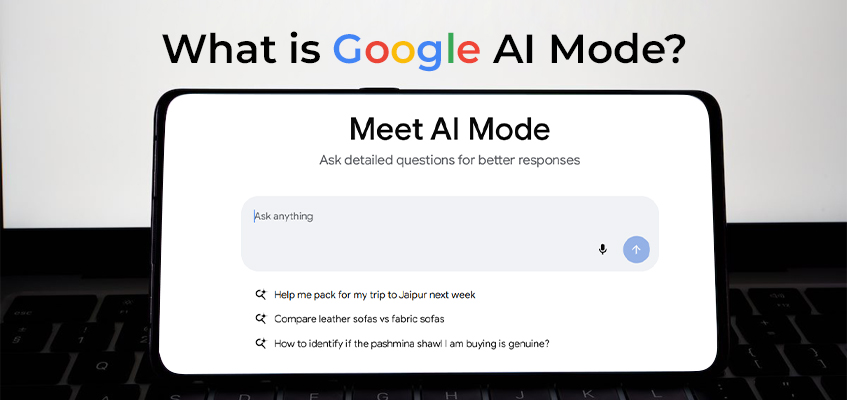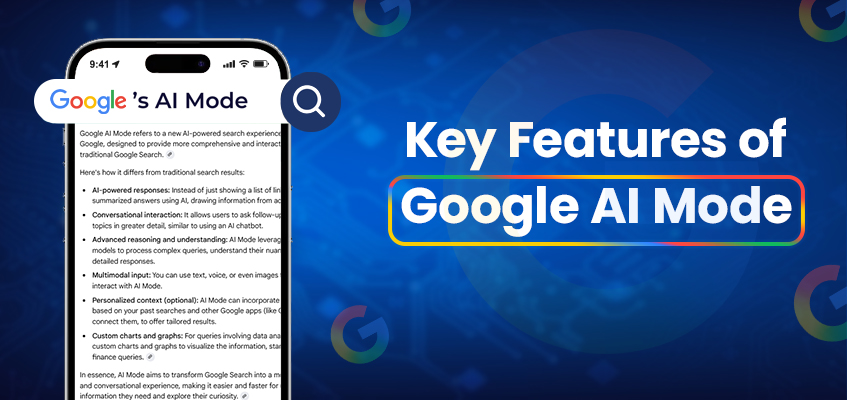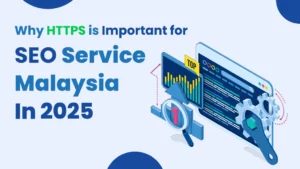Google has once again redefined the digital landscape by launching Google AI Mode worldwide in July 2025. First released in the U.S. in May 2025, Google AI Mode was seen as a glimpse into the future of search. Now, with its global expansion, the tech giant opens a new door to AI-powered, talking search that will change how users spot information and how marketers design content for better visibility.
This rollout brings more than a simple product change as it kicks off a big shift in how search engines talk with users. The old “ten blue links” style steps aside for smart, AI-made answers. For marketers, content creators, and SEO professionals, now’s the time to learn what this new system offers and how to grow with it.

What is Google AI Mode?
Google AI Mode is a standalone conversational search experience introduced by Google in May 2025. It allows users to engage in interactive, multi-turn dialogue, which is similar to tools like ChatGPT or Microsoft Copilot, directly within Google’s ecosystem.
Unlike traditional search, which shows a list of blue links, Google AI Mode delivers full, summarised responses to user queries. Accessible through a separate tab on the Google homepage, this mode provides a more personalised and in-depth way to explore topics, ask follow-up questions and receive context-rich answers in real time.
The tool is designed to deliver real-time answers, drawing from Google’s Knowledge Graph, Shopping Graph, and even personalised content from services like Gmail, Maps and Calendar (with user permission). The result is a more intelligent, context-aware way of answering complex queries.
Google AI Mode – Timeline
The evolution of Google AI Mode is part of a broader journey through Google’s ongoing advancements in artificial intelligence. Below is a chronological breakdown that shows how Google transitioned from early AI research to the global launch of its conversational AI search experience:
May 2017 – Foundation of Google AI
At the I/O conference, CEO Sundar Pichai introduces the formation of Google AI, a dedicated division focused on artificial intelligence research and development. This moment lays the foundation for all future AI-driven tools and features within Google’s ecosystem.
March 2023 – Bard’s Early Access
Google provides early access to Bard, its first-generation AI chatbot built on large language models. Bard begins as a response to growing interest in conversational AI tools and rolls out globally within a few months of testing.
December 2024 – Gemini is Launched
Google launches Gemini, a powerful multimodal AI model capable of understanding and generating text, images, and voice. This marks a significant leap in AI capability, defining the way for more intuitive and responsive user experiences across Google’s platforms.
February 2024 – Bard Merges with Duet AI
Google combines Bard with Duet AI, its workspace assistant, and rebrands the unified system under the Gemini name. This streamlines the company’s AI offerings and strengthens its integration across productivity tools.
May 2024 – Launch of AI Overviews
Google introduces AI Overviews, an AI-enhanced feature within the traditional search interface (formerly known as the Search Generative Experience). These provide AI-generated summaries in search results. The full global rollout is completed by October 2024.
May 2025 – Google AI Mode Launches in the U.S.
Google debuts AI Mode, a standalone ChatGPT-style interface accessible via a separate tab on the homepage. Unlike AI Overviews, this mode offers a more immersive, real-time conversational search experience. Initially, it is only available to users in the United States.
July 2025 – Global Launch of Google AI Mode
Google expands AI Mode access to users worldwide, transforming the way billions interact with search. This milestone signals the global shift toward AI-first search behaviour, where users expect contextual, direct, and human-like responses from their search engine.

Key Features of Google AI Mode
Google AI Mode introduces a powerful set of capabilities that transform how users interact with search. Below is a closer look at the core Google AI Mode features driving this change:
1. Standalone AI Tab
Google AI Mode is available through a dedicated tab on the Google homepage. This splits it from normal search and gives users a clear space to chat with AI, dig into ideas and follow paths in a smarter, deeper way.
2. Multi-turn Conversations
This mode lets users continue to communicate with the AI, not just ask once. They can ask related questions again, define intent and further go deeper into a topic just like speaking with a human assistant who communicates clearly.
3. Real-Time Data Integration
Google AI Mode pulls real-time information from the web and internal graphs like Google’s Knowledge and Shopping Graphs. This ensures up-to-date, dynamic answers that reflect current events, market trends or fast-changing user queries.
4. Personalised Assistance
If users permit, the AI integrates with personal data from Gmail, Calendar, and Maps. This enables Google AI Mode to provide contextually relevant answers, such as suggesting nearby events or surfacing emails related to a search query.
5. No Traditional Link List
Unlike classic Google results, AI Mode responses do not include a list of blue links. Instead, only credible, cited sources appear in summarised form, increasing competition for visibility and transforming how SEO operates.
6. Citation-Based Visibility
Google picks content that shows strong quality, trust, and truth to mention in AI answers. This means you must build smart, clear content and grow your brand name to stay seen in AI-made search results.
7. Ad-Free Experience (for now)
In July 2025, Google AI Mode keeps out ads, giving users a clean and quiet search space. This helps people trust answers and stay focused on what matters most. Google may add ads later, but right now, it stays simple and quiet.
8. Manual Activation Required
Users must intentionally switch to AI Mode; it doesn’t auto-trigger based on queries. This behaviour shift encourages deeper engagement but requires user awareness, making initial adoption more deliberate than traditional Google search.
How Does Google’s AI Mode Work?
Google AI Mode represents a significant evolution in how users engage with search. Rather than relying on traditional keyword-based queries and a list of links, it introduces a conversational interface powered by generative AI, delivering contextual, personalised, and real-time responses.
At its core, Google AI Mode uses large language models to interpret user intent and generate multi-step answers that resemble human dialogue. This enables users to conduct follow-up interactions, allowing for deeper exploration of complex topics. It’s not a static search result—it’s a fluid, intelligent exchange.
What makes Google AI Mode particularly powerful is its integration with Google’s data infrastructure. It pulls information from:
- Google Knowledge Graph – for verified facts and relationships
- Shopping Graph – for real-time product details and pricing
- Live web content – ensuring that answers reflect the most current information available
- Personalised services (optional) – such as Gmail, Calendar, and Maps, with user consent
This combination allows the system to provide highly relevant and timely responses, tailored to individual users. For instance, a user might ask, “What time is my meeting today?” and receive an answer drawn directly from their Google Calendar.
Unlike traditional search results, Google AI Mode skips the usual list of ranked links. Instead, it builds a short, smart answer that pulls from only trusted, high-quality sources. This moves visibility away from old SEO rankings and points it toward citation-based success. So, content creators must focus on truth, clear structure, and strong value to earn a spot in AI-driven answers.
If you’re wondering how to use Google AI Mode, it’s simple—just click the AI tab on Google’s homepage, type your question, and start chatting. The smart system will guide you with real-time answers built just for your needs.
By mixing natural language smarts, real-time data, and personal help, Google AI Mode shapes search into a helpful, guided journey. It jumps ahead into smart, talking search that changes how people explore digital content—and how businesses must keep up to stay seen.
How Does Google AI Mode Impact SEO & Digital Marketing?
The implications of Google AI Mode SEO are profound. Since the tool doesn’t show a list of search results by default, your site could be completely invisible unless cited within the AI’s answer.
Here’s how this impacts SEO and digital marketing:
- EEAT Optimisation: To stay visible, your content must focus on Experience, Expertise, Authoritativeness, and Trustworthiness (EEAT). These are key signals Google AI uses to decide which content deserves a spot. Top SEO Malaysia strategies now centre around EEAT strength.
- Less Click-Through Traffic: Since users grab answers right away, they tap on fewer website links.
- Content Quality Over Quantity: To get seen, your content must bring new ideas, follow a smart structure and dig deep into real facts.
- Brand Authority: Sites that shine with strong names and collect mentions from trusted places win more space in Google AI Mode in search.
If you’re running a digital marketing agency Malaysia or are focused on SEO then adapting to this shift is vital.
Google AI Mode Vs Google AI Overviews
Though both use generative AI, there are key differences between Google AI Mode and AI Overviews:
| Feature | Google AI Overviews | Google AI Mode |
|---|---|---|
| Location | Embedded in traditional search results | Separate tab on the homepage |
| Trigger Mechanism | Auto-triggered based on query | Manually activated by the user |
| Interaction | One-off answer | Multi-turn, interactive conversation |
| Personalization | Limited | Deeply integrated with Google services |
| Availability | Global | Now global as of July 2025 |
| SEO Impact | Reduces traffic through quick answers | Citation-based visibility, no link list |
In short, Google AI search mode is far more immersive and engagement-driven, while Overviews are quick reference tools within the old search layout.
Conclusion
With the global release of Google AI Mode, we are stepping into a new era of conversational search—one that’s more intelligent, personal, and AI-driven. For businesses and marketers, this means rethinking SEO from the ground up.
Success now hinges on building trust, demonstrating authority, and being structurally sound in your content creation. This isn’t about gaming algorithms anymore—it’s about providing real value that AI will choose to cite.
The days of keyword stuffing and backlink chasing are fading. The future belongs to those who can deliver relevance, credibility, and conversation-ready content.




